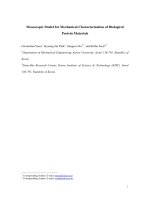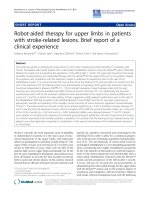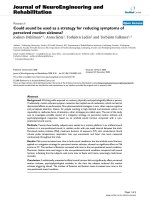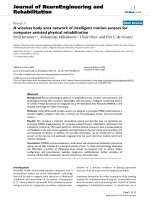Computer aided simulation for non-linear model of ship motion
Bạn đang xem bản rút gọn của tài liệu. Xem và tải ngay bản đầy đủ của tài liệu tại đây (151.27 KB, 5 trang )
Journal of Mechanics, NCNST of Vietnam T. XVI, 1994, No 2 (33 - 37)
COMPUTER AIDED SIMULATION FOR
NON-LINEAR MODEL OF SHIP MOTION
NGUYEN NHAT LE
SUMMARY. The ship motion is simulated on computer by non-linear model of small vibration
and strong non-linear model.
The results are compared between two models.
The influences of
different parameters to the ship motion are considered.
§1.
INTRODUCTION
The non-linear model simulation of ship motion has been studied by Nguyen Van Dao [1].
proposed model consists of a mass M restrained by a non-linear elastic spring and a mass m
,ched to a hinged, weightless rod {Fig. 1). This sfstem has the vertical and angular oscillations.
§2. SIMULATION FOR NON-LINEAR MODEL
OF SMALL VIBRATION
The .differential equations of motion for the system represented in Fig. 1 are writen as follows
+ m)(Z + u) + k 0 Z + fJ 0 Z 3 + h0 Z + ml(9sin 'P +<{?cos 'P)
m£2 9 + Co
=
o
( 2.1)
~e Z = x - u is the relative vertical displacement of the mass M; x is the vertical displacement
te mass M from its static position of equilibrium; u = q cos wt is the vertical displacement of
base of the system; rp is the angular displacement of the pendulum; k 0 and {30 are the linear
non-linear characteristics of the spring, respectively; ho and Co are the damping coefficients
.e vertical and angular motions, respectively.
Supposing that the damping forces and the ratios"= qjl; p. = mj(M + m) are small, the
rential equations of small vibrations are written as follows [1]:
W"
+ k2 W
=
-«[- ary 2 cosryr + hW' + fJW 3 + P.('P'P" +
11
+
11
e
33
+ at] 2 rpcosryr] + e2 ••.
(2.2)
z
w
W=-·
t ,
h =
'J=-
j
Wo
=If;
Wo
I?=
ho
wo(M+ m)
m
Jl=
a=!!.;
(M +m)
t
ko
w5(M +m)
T
(3=w5(M+m)
= wot.
Computer aided simulation for differential equations of small vibrations {2.2) with the different
data in ]1] with:
Jl
= 0.05;
k
= 2;
h
= C = 0.10; "= 4.5 · w- 2 ;
(3
= 0 and (3 = 1
we obtain the behaviours of so(t) and W(t) as shown in Fig. 2. Where so(r): damped vibration,
W (r): periodic vibration affter a time.
The change of coefficient (3 ((3 = 0 or (3 = 1) and the change of coefficient ry have a very small
influence to the motions.
,
I
'
I
IIIIIIA~~~~~~~A(.·~-~~~~~~
vlf v
v
m
-
0.0000
____ f :
'fJ(C}
----2
W(r}
T tme
I
Fig. 1
'
fig. 2
§3. SIMULATION FOR STRONG NON-LINEAR MODEL
For general strong non~linear model of ship motion, the differential equations of motion has
the form {2.1). This form has been studied by means of the asymptotic method of non-linear
mechanics [1). It is can be.simulated on computer as shown in Fig. 3:
With this computer aided simulation ~e can observe all motions correspondi.ng to the different
real parameters-.
1. Influence of the non-linear damping coefficients:
Making change the non-linear damping coefficients, we see that the term f3o in the non-linear
characteristic of the spring has a very small influence to the vertical motio~, while the damping
term Co of the angular motion has a considerable influence to this motion.
2. Influence of the length of the rod:
Taking the ratios
34
Jl. = (M:
m) = 0.05;
u=
~
= 0.045;
ry=
w
1.8
wo
the change of q and l has a influence to the behaviours of motions.
- _with l = 2.2, q = 0.1: The response curves of displacements Z and rp are plated in Fig. 4
Fig. 9
if! It)
.t
0' 0000
1). 1000006
0 2000000
O.Jaooooo
a. .Jtl&oooo
0. JOOOOOG
0 2931420
0.25fi51i'OO
o. 5000000
0.6000000
a.
0.4ooaooo
q.
roooooo
(), 8000000
0-9GOOO(f(}
t.oooa
1 UJOO
I 20 00
;
.300 0
1.4000
I. 50~0
1 6a a~
1- ?000
1-8000
-1' ~0{] 0
2.0000
2' 10 ~0
2-lOOO
2. JO Ofl
2 -4JOO
2. sooo
2. 600 0
~~-
2J8621C
nssago
lZ1725D
(). 0650743
a. aosaBeo
-o.
05i€1155
-o.
IB93S'Iio
-0.
2~
-lo7J970
-'. f540
_,
140
U860
-O.t20Jf50
e It)
a.
~oaaoco
•.1oaoaoa
0. 0952.1:113
0 .085i727
o. 06644Ji
0. OJ6HSS'
·0. 00662li!;
·0 .0:1·0 H568S.O
-0. 1665080
-0 . 200<11/D
-0-.2{75380
().01080~!
·0 .20593'f.O
0. 175!t800
0. 2.61'18~0
o. 3101000
-0
_,
1.;~•~~o
-·0. (67J940
-a.
~"4
It 50
IIB~b8D
- 0. ~'11 G46t
-~- 06-17130
Ji!:lH~D
'0o. 25,516a
j
2
11;,
2
-D- -12!55060
-o. 25rs7'0a
o.a::~aurs
-0.352.12'70
-O.J>~a5460
2
2
0.62~l57+
{]. 00-499<98
i
2
154846'0
-O.a2.9-1Bsl
0.06!12~21
t
-0. 201!8010
- o. 4834020
·0. HJ50fa
-o. 0347029
0.0000
Time
'
-----
2
~
~' rp ( t)
----2'
~It)
50
.
Fig.
4
Where, the angular displacement IP is damped, while the vertical displacement Z has a beat
phenomenon.
Thus, corresponding with the observation in [1], for the cas.e considered this is only the purely
vertical motion.
35
- with l = 1; q = 0.'045: the shape of the response curves and the coupling between are shown in Fig. 5. Where, both the behaviours p(t) and Z(t) have the beat phenomenon.
2
----1 .'
----2. l(f)
Fig. 5
3. Coupling between vertical and angular motions:
The coefficient '1 = .w fwo has a essential influence on the coupling between vertical and angular
motions. However the coupling b.etween two displacements ~ and Z is small with
1.65 :5 ry < 2
where p(t) is damping oscillation, Z(t) has the beat phenomenon.
Its behaviours are analogous with those in Fig. 4.
The coupling strongly occurs in the resonant regions, i.e.
2 = ry :5 2.12
The coupling at the resonance (ry = 2) is ploted in Fig. 6.
Re5onance ('),= 2)
iiJWVWfM!iMJ,
1.
i
____ /
'P{I)
---2
i!(t)
0. 0000
50.0000
Fig. 6
36
With YJ 2 2.5, the shape of the response curves is analogous with that in Fig. 5.
4. Others influence of 'the parameters:
Making change others parameters of the different blocs in the flow diagram on Fig. 3 we can
see on computer screen the direct displays of different motions considered.
Basing on the study in [1] and the computer aided simulation we can observe others phenomenons occured by t.he strong non-linearity of the system (2.1). Also, we can select the convenient parameters to occur the desirous motions.
CONCLUSION
The ship motion is simulated on computer by two models of small vibration and of strong
non-linearity.
The influences of different parameters are considered and corhpared. The experimental results
are in accordance with theoretical ones [1]. With this computer aided simulation we can select the
reel parameters to find the convenient motions.
This publication is completed with financial support from the National Basic Research Program· in Nat ural Sciences.
REFERENCES
1.
Nguyen Van Dao. Non-linear model simulation of ship motion. Journal of Mechanics, T. XIV,
No 2, 1992.
Received May 3 1 1993
MO PRONG TREN MAY VI TiNH MO HINH PHI TUYEN
'
,J
"
'
'
CUACHUYENDQNGTAUTHUY
MO .hlnh phi tuyen yeu cho dao d9ng lktc ngang_ va th~ng dU.ng ella tau thdy di duyc nghien
cU:u b~ng plnrang phap ti~m c~n ella dao d9ng phi tuyen [1].
Trang bai nay, mO hlnh phi tuye'n tren di drrq'c mO phdng tr&n may tinh, v&i hai mO hlnh:
dao di?ng b€ va. phi tuye'n m<_tnh. Da xet inh hrr&ng cUa d.c thOng sO den dang di~u cUa chuy~n
di?ng. V&i sv mO ph6ng nay, chUng ta c6 th~ d~ dang thay d&i c&c tham sO va quan sat trlfc tiep
tren man hinh c
37









